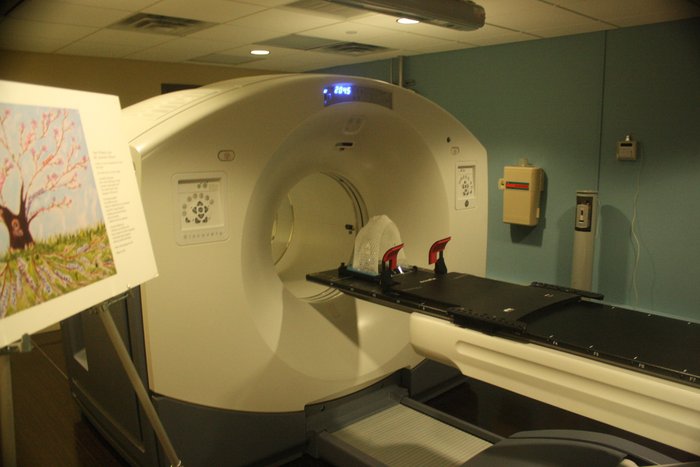The lights in the treatment room turned colors – first pale blue, then indigo, then a soft pastel red – somehow making the place seem less formal and less terrifying.
The last thing people coming in to get radiation treatment to fight cancer want to feel is intimidated.
So staff in the room can modify the lights, making the space feel less like a clinical laboratory and more like someone’s home with the lights dimmed.
Many might take comfort in the fact that the radiation-therapy technology that the room contains is the most advanced available, and better suited to more precisely treat the area of cancer each particular patient has.
Called a linear accelerator, the machine can effectively treat cancer areas with little or no damage to unaffected areas of the body, part of the latest generation of treatment that uses precision treatment techniques.
This treatment room and the newly installed PET/CT a few doors away are part of a newly rebuilt cancer center at Bayonne Medical Center, which opened its doors in late January after more than seven months of rebuilding – literally from the ground up.
“Services like this allow people to stay close to home for quality treatment rather than being forced to go out of the area.” – Dr. Mark Spektor
____________
According to Brianne Keenan, executive director of Peninsula Radiation Oncology Services, the new center rebuilt on the footprint of the old center will work in conjunction with hospital staff elsewhere in BMC to diagnose and develop appropriate treatments for each cancer patient.
Most advanced treatments for cancer
The new PET (Positron Emission Tomography) scanner replaces a less sophisticated portable scanner, which was only available at the hospital previously once a week. This is a device that produces a three-dimensional image or picture of functional processes in the body. It is used to detect cancer, determine whether a cancer has spread in the body and if it has returned after going into remission, and look at a number of heart and brain related issues.
Using the new PET/CT scanner to pinpoint the extent of cancer, doctors will determine what option is best suited for each patient: surgery, chemotherapy, or radiation.
“This will determine the severity of the cancer and where it is located,” Kane said.
If radiation is the option, patients are then scheduled for treatment with the linear accelerator, which generally takes about 15 minutes per treatment.
She said there is a significant need for the facility in Hudson County where cancer rates – some believe caused by waste from previous manufacturing and other chemicals – are very high. This facility has the capacity to treat up to 50 more people a day with radiation therapy.
Along with the two treatment rooms, the 5,200 square-foot Lorraine M. LaPilusa Cancer Treatment Center at BMC features patient friendly waiting, evaluation, and treatment rooms, and a staff of 10, as well as two radiation oncologists.
center for cancer treatment since 1992
As with many of the upgrades to BMC made by the new owners since 2008, most of the $5 million for this project came as an investment by the owners – although $200,000 came from the estate of Eugene McNally, bequeathed to the hospital in his will.
Treated for a short time at BMC during the last years of his life, McNally apparently never forgot the work he and others did establishing the cancer center back in 1992, or how much it was needed then and now.
The cancer center first opened its doors in October 1992 and allowed for patients to receive local treatment for the first time rather than traveling out of Bayonne.
The center was named after the wife of a prominent orthopedic surgeon, Salvatore J. LaPilusa, who became the chief orthopedic nurse at BMC before taking over management of her husband’s medical office in Bayonne.
Vowing that Bayonne residents would not have to travel to New York for treatment, Dr. LaPilusa joined with other residents to fund the creation of the center. LaPilusa became the chairman of the fundraising project called “Together for Life,” which raised nearly $4 million that the center needed, and that amount was backed by the Bayonne Hospital Foundation. McNally was one of the members of the Founders’ Committee.
Considered the Bayonne hospital’s most significant project for 1992, the facility provided more than 700 radiation therapy treatments in its first two months of operation. The facility far exceeded that amount in the following year, when it provided more than 5,000 treatments.
At the time, the pavilion was considered one of the most sophisticated cancer treatment facilities in New Jersey. The latest upgrades, according to Kane, renew that distinction, making BMC a treatment center not just for people of Bayonne, but for the region.
“This is part of our plans for the hospital,” said newly named CEO Dr. Mark Spektor. “Services like this allow people to stay close to home for quality treatment rather than being forced to go out of the area.”
BMC had its accreditation renewed earlier this year with the Commission on Cancer of the American College of Surgeons, and is currently the only accredited cancer program in Hudson County.
